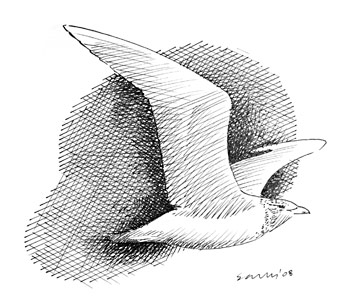Glaucous Gull (Larus hyperboreus)

Glaucous Gull © Ray Scally
This ghostly visitor from the north has been seen far less often in the last decade in Cheshire and Wirral, and also in adjacent Lancashire and North Merseyside (White et al 2008). The explanation for the decline may well, as with Iceland Gull, be the recent run of warmer winters. This Atlas map typifies their recent distribution, with most records from waste disposal sites or associated loafing areas, or roosts of birds which feed on the tips. Most Glaucous Gulls in Britain used to be at the coast, where they feed on fish and any edible detritus (BTO Winter Atlas) but the proportion inland has increased over the years, and the two birds found in three Dee estuary tetrads in this survey were the first wintering coastal records since December 1999.
Glaucous Gulls come here from breeding grounds in Norway, Bear Island and Iceland, and possibly Greenland (Migration Atlas). Most records in Britain are of first-year birds, which often wander widely, or of adults, many of which are thought to return to a favourite site (Migration Atlas). They were unknown in Cheshire and Wirral until fifty years ago, but the first bird recorded within the present county boundaries set the tone for this species’ typical behaviour. It was initially seen as an immature in the Hilbre-Hoylake area on 15 September 1957. The gull stayed in the vicinity for eighteen months, until 8 April 1959 – still the longest stay by a Glaucous Gull in the county – and reappeared the following winter almost in adult plumage. It then returned to the same area in each winter until it was last seen in March 1963.
After that first bird in the county, Glaucous Gulls were recorded in every year except 1967, with birds in each winter apart from 1968/ 69 and 1970/ 71, although they remained scarce until the late 1970s. It is impossible to tell whether the rise in records from then on was a real reflection of more birds being present, or a shift in birdwatchers’ habits to pay more attention to refuse tips and nearby pools, where gulls washed, and to overnight roosts such as Doddington and Rostherne. The national winter atlas, from 1981/ 82 to 1983/ 84, probably stimulated more winter recording, and the publication in the early 1980s of some specialist identification guides to gulls and seabirds probably prompted more records as well. Whatever the reasons, the annual bird reports show far more records of Glaucous Gulls in the county in the 1980s and 1990s.
Records in this period are fairly evenly split between coastal and inland sites with the majority of the latter from our defined winter period while most of the coastal ones fall outside it, particularly in spring passage. Of the winter months, January and February have the most sightings, with numbers varying considerably from year to year. In some winters only odd birds are seen while in others sites such as Fiddler’s Ferry/ Richmond Bank and the Witton Flashes, both adjacent to large refuse tips, have held several different birds of various ages. Another regular visitor was recorded at Thurstaston: first appearing as an immature bird in October 1981, it returned to the same area each winter until it was last seen in January 1992.
Nearly all of the records during this atlas survey were in winter 2004/ 05, with just one bird at Hurleston Reservoir (SJ65H) in January 2006 and none at all in 2006/ 07. Some birds moved between tetrads whilst other sites were visited by several different birds. An adult was at Little Eye (SJ18Y) and West Kirby (SJ28D) in January 2005. One or two first-winter birds were at Maw Green Tip and adjacent flashes (SJ75D/ E/ J) while three different first-year birds were thought to have been seen at Richmond Bank (SJ58T).
Sponsored by Brian Dyke

